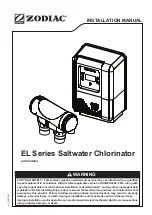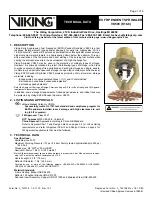
Hydrocyclon
System
The filtration is produced by capture of particles with specific weight greater than water, by the centrifugal force that
causes these particles to spin at high speed onto the filter walls in a tangential direction. The dirt is forced onto the
walls of the hydrocyclone and falls into a collection chamber that is located at the bottom of the filter. The water, that
has been cleaned of the heavier particles which were carried in suspension, passes to the outlet to be filtered of finer
and lighter particles by conventional filtration systems.
The hydrocyclone must always be installed vertically.
Dirt is collected in a purge chamber, which can be flushed manually or automatically, with the fitting of a auto flush kit.
A simple system, easy to use and very economic.
Hydrocyclones solve, more effectively than any other system, problems of excessive sand in the water. They can elimi-
nate up to 80% of the sand being carried in the water. Downstream disc or screen secondary filters are recommended.
Maximum working pressure 10 Kg/cm². Test pressure 15 Kg/cm².
The manufacturer is not responsible for products damaged by incorrect use or water hammer. The manufacturer is
not responsible for products with corrosion from the internal abrasive action of sand either. We recommend a periodic
cleaning for a longlife.
Installation
Vertically over colectors or over three legs support (non supplied).
The model and number of hidrocyclones depends on the flow, and for a correct use it needs an aproximated head
loss of 0,5 Kg/cm².
Check the water flow direction and instal a stravenge key (non supplied).
Install the hidrocyclon keeping enough space in the down side, for the accumulator deposit. For a greater confort you
can instal an automatic stravenge kit optional.
The hydrocyclones can suffer wear by graze, this incidence is not covered by guarantee.
Cleaning
These systems, which separate the dirt from the water directly, do not require any disassemble to clean the filters them-
selves. The dirt accumulates in the purge chamber and must be regularly eliminated.
The cleaning process can be manual, with the use of a simple handle, or automatic with the incorporation of a auto-
matic cleaning kit (Optional). When escapes appears by wear, it should be repaired by hadmade or to be replaced.
Applications
They are specially designed to separate solids with a higher specific weight than water which are in suspension in
water: sand, small stones, mud...
Specially recommended to use in wells that produce excess sand.
Ready for use as pre-filtration of conventional filtration system. (See design). Not recommended to be used as the only
filter type in a system.
Because the filtering operation is a different process to the conventional filters, both minimun and maximun flow rates
must be taken into consideration when designing a system. If a hydrocyclone system is oversized for a particular appli-
cation internal flow rates will be too low and the filtering effect will not occur.
Technical Information
A
B
(mm)
C
(mm)
D
(mm)
E
(mm)
Net
Weight
(Kg)
Gross
Weight
(Kg)
Package
Volume
(m
3
)
Flow
Limit
(m
3
/h)
Description
Code
1½” Thread M
100
110
460
168
8,5
9
0,010
12
Hydrocyclone 1½”
HI1M
2” Vic
119
200
860
250
15,5
16,5
0,050
22
Hydrocyclone 2” Vic
HID2
2” Thread M
119
200
860
250
15,5
16,5
0,050
22
Hydrocyclone 2” Thread
HI2E
3’’ Flange
185
350
1415
500
42
43,5
0,350
50
Hydrocyclone 3”
HID3
3’’ Flange
147
210
937
300
-
-
0,080
25
Hydrocyclone 3”
HID3C
4’’ Flange
185
313
1329
500
-
-
0,330
60
Hydrocyclone 4”
HID4
Detachable three legs support (mod. HID2)
SHP2
Detachable three legs support
(mod. HID3)
SHP3
Automatic Cleaning Kit
2’’ 220V
(Valve, timer, transformer, solenoid and Filter)
for one hydrocyclone
KL2C
Automatic Cleaning Kit
2’’ Pilas
(Valve, timer, transformer, solenoid and Filter)
for one hydrocyclone
KL2MO
7
EN
ENGLISH
Hidrociclón
No standar
configuration






























